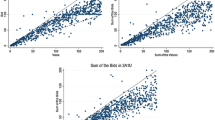Abstract
I derive the incentive compatible and individually rational mechanism that maximizes the sum of the buyers’ ex-ante expected utilities. I also show that this mechanism minimizes the seller’s revenue. When payments are required to be non-negative, my mechanism takes the form of an arbitrarily weighted lottery with no participation fees, and the resulting allocation is generally not ex-post efficient. This means that before learning their valuations and if side payments from the seller to the buyers are not allowed, buyers as a group would be better off if they gave up ex-post efficiency in order to avoid positive payments. When transfers are allowed, the optimal mechanism is a standard auction with no reserve price and where the seller’s income is redistributed back to the buyers. This mechanism is robust to speculators if a buyer with value 0 never partakes in the redistribution.

Similar content being viewed by others
Notes
Corchón and Serena (2018) provide a good summary of the recent contest theory literature.
Specifically, New Zealand Government’s Explorer Grants and Volkswagen’s Experiment! Grants.
I thank an anonymous reviewer for pointing out this particular point.
This is so because:
$$\begin{aligned} \textrm{E}_{\theta _i}\left[ \frac{1}{\lambda _i\left( \theta _i\right) }\right] =\int _{\varTheta _i}\left( 1-F_i\left( \theta _i\right) \right) d\theta _i=\overline{\theta }-\theta _iF\left( \theta _i\right) \Big |_0^{\overline{\theta }}+\int _{\varTheta _i}\theta _if_i\left( \theta _i\right) d\theta _i=\textrm{E}_{\theta _i}\left[ \theta _i\right] \end{aligned}$$
References
Athey S, Bagwell K, Sanchirico C (2004) Collusion and price rigidity. Rev Econ Stud 71(2):317–349
Bohanon C, Coelho P (1998) The cost of free land: the oklahoma land rushes. J Real Estate Financ Econ 16(2):205–221
Börgers T (2015) An introduction to the theory of mechanism design. Oxford University Press, New York
Bulow J, Klemperer P (1996) Auctions versus negotiations. Am Econ Rev 86(1):180–194
Bulow J, Klemperer P (2009) Why do sellers (usually) prefer auctions? Am Econ Rev 99(4):1544–1575
Bulow J, Roberts J (1989) The simple economics of optimal auctions. J Polit Econ 97:1060–1090
Clarke E (1971) Multipart pricing of public goods. Public Choice 2:19–33
Corchon L, Serena M (2018) Contest Theory: a Survey, in Corchon L, Marini M, Handbook of Game Theory and Industrial Organization. Edward Elgar Publishing, London
Groves T (1973) Incentives in teams. Econometrica 41:617–631
Klemperer P (2004) Auctions: theory and practice. Princeton University Press, Princeton
Krishna V (2009) Auction theory, 2nd edn. Academic Press, San Diego
Menezes F, Monteiro P (2005) An introduction to auction theory. Oxford University Press, Oxford
Milgrom P (2004) Putting auction theory to work. Cambridge University Press, Cambridge
Muto N, Shirata Y, Yamashita T (2020) Revenue-capped efficient auctions. J Eur Econ Assoc 18(3):1284–1320
Myerson R (1981) Optimal auction design. Math Oper Res 6:58–73
Roberts J, Sweeting A (2013) When should sellers use auctions? Am Econ Rev 103(5):1830–1861
Scrogin D, Berrens R (2003) Rationed access and welfare: the case of public resource lotteries. Land Econ 79(2):137–148
Vickrey W (1961) Counterspeculation, auctions and competitive sealed tenders. J Finance 16:8–37
Acknowledgements
This paper is a modified version of my master’s thesis at the Torcuato Di Tella University. I am greatly indebted to Leandro Arozamena and Federico Weinschelbaum for their work as thesis advisors. I also thank the valuable comments and suggestions of Susan Athey, Jeremy Bulow, Nick Cao, Matias Cersosimo, Florencia Hnilo, Pedro Martínez Bruera, and of two anonymous referees and an anonymous editor.
Author information
Authors and Affiliations
Corresponding author
Ethics declarations
Conflict of interest
The author declares that he has no conflict of interest.
Additional information
Publisher's Note
Springer Nature remains neutral with regard to jurisdictional claims in published maps and institutional affiliations.
Rights and permissions
Springer Nature or its licensor (e.g. a society or other partner) holds exclusive rights to this article under a publishing agreement with the author(s) or other rightsholder(s); author self-archiving of the accepted manuscript version of this article is solely governed by the terms of such publishing agreement and applicable law.
About this article
Cite this article
Bauer, S.D. Buyers’ welfare maximizing auction design. Int J Game Theory 52, 555–567 (2023). https://doi.org/10.1007/s00182-022-00829-w
Accepted:
Published:
Issue Date:
DOI: https://doi.org/10.1007/s00182-022-00829-w



